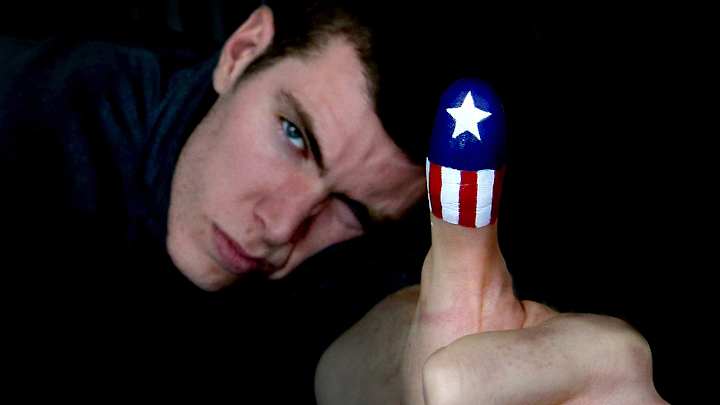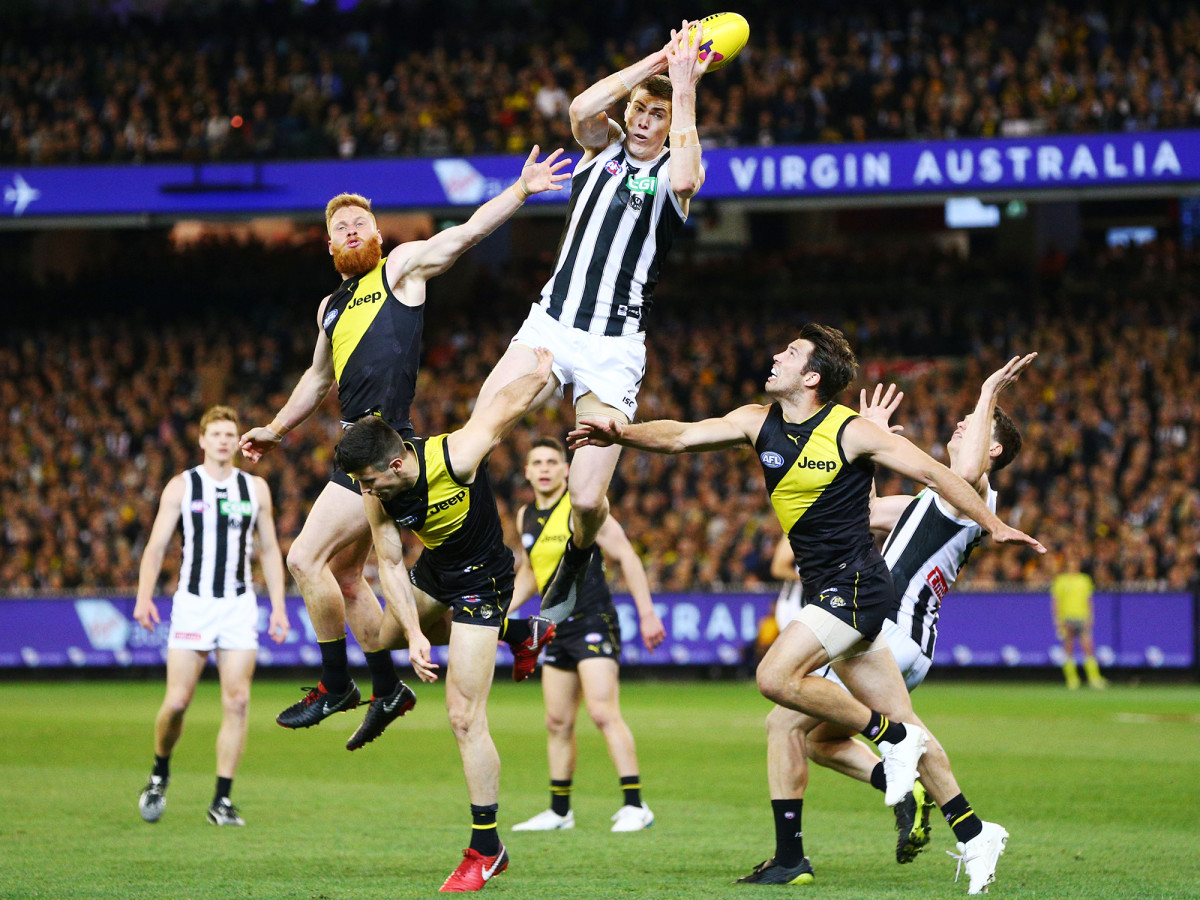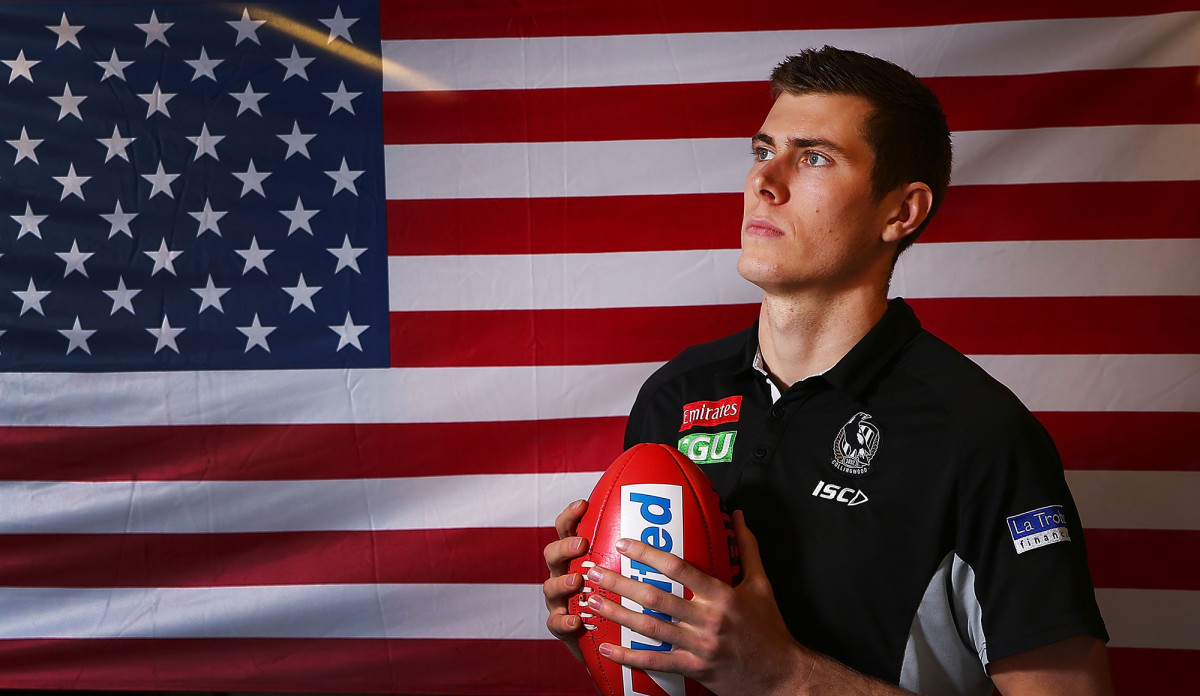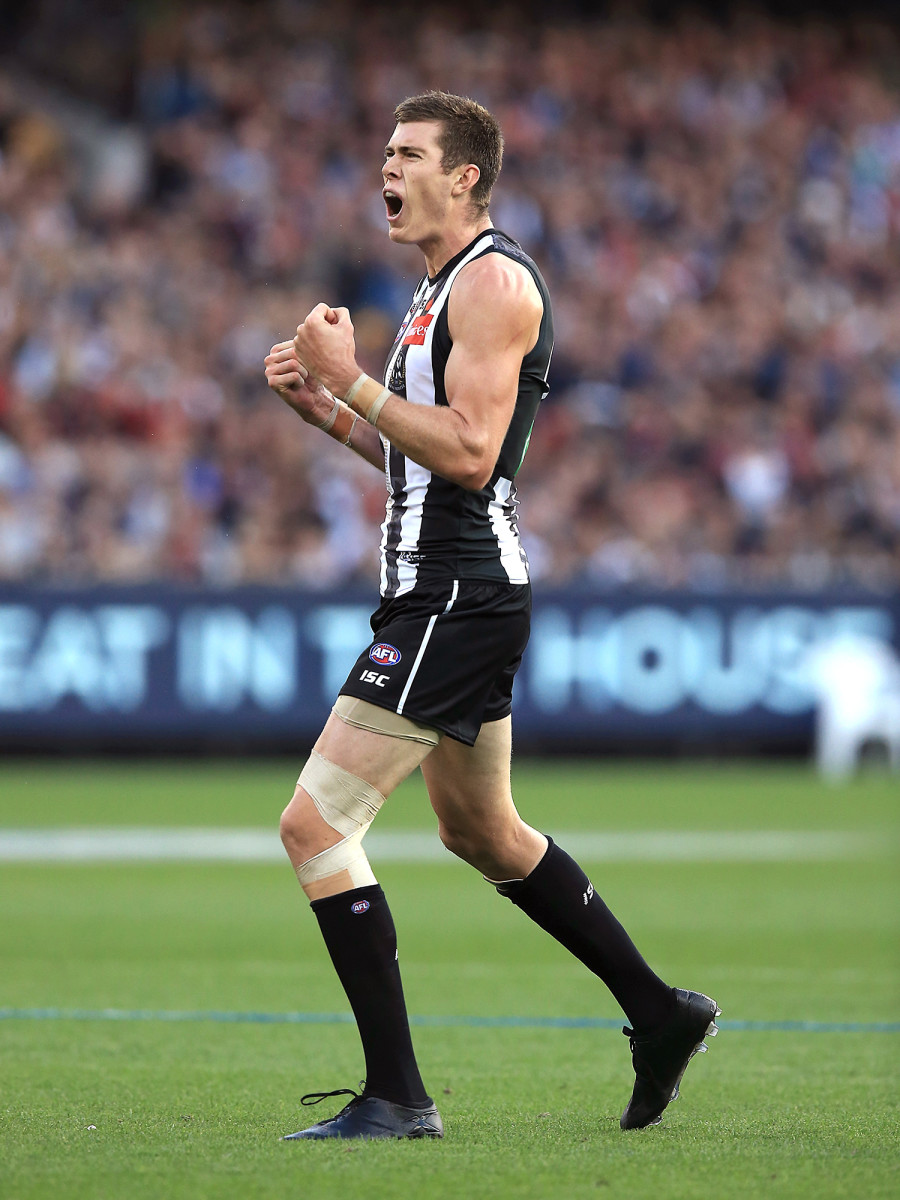Mason Cox's Unlikely Journey From Oklahoma State Stand-In to Australian Rules Football Star

The story of how 6’11”, former Oklahoma State basketball player Mason Cox landed in the Australian Football League Grand Final—the sport’s equivalent to the Super Bowl—has captivated a sport-crazed nation. But no one is more surprised by what is in every way a very tall tale than Cox himself.
A 27-year-old from Highland Village, Texas, Cox will play for Melbourne team Collingwood against the Perth-based West Coast Eagles in a title game that will draw a crowd of 100,000 to the iconic Melbourne Cricket Ground. But Cox had never even heard of Australian Rules football four years ago.
“I had to Google it,” said Cox of his reaction when an Australian Rules scout hunting for college basketball cast-offs contacted Oklahoma State to see if he was interested in a trial. “The first thing that came up was ‘The Biggest Fights in AFL History’ or something like that. It was a bunch of fights and people getting knocked out. I thought, Looks pretty fun, I might give this a go.”
Cox’s search engine research of obscure international sports occurred just after he had left Oklahoma State in 2014 with a mechanical engineering degree. He was preparing to take a job with ExxonMobile in his native Texas, following in the footsteps of his parents, Jeanette and Phil, who were both engineers.
A career as a professional athlete was the furthest thing from Cox’s mind. He mostly played soccer growing up and while in college, he picked up recreational basketball because of his enormous size. “It was just one of those things I never really got into [growing up],” he says. “I just picked up a basketball one day and said, Heck, I’m almost seven feet tall, I might as well try it.”
Cox’s older brother Nolan had occasionally helped out the Oklahoma women’s team. When the Cowgirls were preparing for a game against Baylor and their future WNBA star center Brittney Griner, the team called on “little brother” Mason to simulate the 6’9” Griner during training drills.
Cox was thrilled just to “get free shoes and stuff” for working with the women’s team, but because of his sheer size and athleticism, he soon caught the eye of the OSU men’s coaches and became a walk-on in 2011–12. By Cox’s modest assessment, his two seasons of college ball were not stellar.
“Pretty lackluster,” says Cox when asked to sum up his career. “For two years I was not even on the bench, I was behind the bench. I would suit up but the weights coach and assistant coach got a seat ahead of me. I was at the back next to the team manager.”
So while teammates such as future Boston Celtics star Marcus Smart prepared for careers in the NBA, Cox continued to work on his grades as much his jump shots. He had already cleared out his dorm room when he was called back to campus—a media officer had a message for him from a basketball scout sidelining for the Australian Football League.

For the second time in his college career, Cox’s unmistakable, towering figure had attracted attention. The scout wanted him to attend a trial in Los Angeles with about 20 other college ballers who were not up to NBA draft standards, but still considered big and athletic enough to adapt to the Australian game. But before he agreed, Cox needed to be sure the Australian Football League was “a real thing” and not some kind of sporting Ponzi scheme.
“I thought it might be like some Eastern European basketball league that would fold a week after I got there. Or I might be get stuck in Botswana or somewhere without any way to get home,” says Cox, who was eventually convinced of the league’s bone fides by an Australian tennis coach at Oklahoma State.
Even then, Cox only agreed to attend the trial for a couple of all-expenses-paid days in Los Angeles. But after sessions of catching and kicking the odd shaped ball in front of the Australian scouts, he found himself on a flight to Melbourne where, once he landed, several clubs took immediate interest in the giant American and were soon fighting over his signature on their AFL contracts.
The country’s national sport, Australian Rules is big business in a small market. The 18 AFL teams fight for a limited supply of athletes in a nation of 25 million where rugby league, rugby union and soccer also have relatively strong professional franchises. Over recent decades, AFL clubs have attempted to boost their numbers by recruiting by Irish Gaelic Footballers, and more recently, African immigrants.
With its surfeit of college athletes, some see the U.S. as a well-stocked pond. Still, even as Cox gradually honed his skills on the training ground with his new club Collingwood, the idea of the gargantuan American perfecting the game remained as unlikely to Australians as it had seemed to Cox.

Other than his size and his unexpected, underwhelming college basketball career, Cox had no real sporting pedigree. “I think my dad’s got a bowling ball and my mom played adult league volleyball,” he says. And then there is the seemingly impenetrable nature of Australian Rules football, which is played on a vast field with an oval ball and has what looks like, at least to outsiders, a quite violent disposition.
“There were a lot of things that were hard to master,” says Cox. “The kicking and marking [catching] and handball [punching the ball from the palm of the hand with a clenched fist].
“But the hardest thing was just trying to prove myself. In my mind, the coaches were all thinking, ‘You’re some big American with zero experience. Why should I play you?’ But I didn’t want to be a one-and-done—some American guy who came out here and no one ever heard of again. So I kept at it.”
Collingwood gave Cox specialized training and persisted with him in their reserves team before his debut game in April 2016, just two years after he had first picked up a ball. Cox rewarded the faith by scoring a goal with his first kick, a feat that seemed to astonish his excited Aussie teammates as much as the typically raucous crowd of 95,000. When he attempts to explain his unexpected transformation from would-be engineer to Australian Rules star to friends back home, Cox finds it difficult to describe the environment.
“No one can really understand it until they come to Melbourne and experience it,” he says of the hype that surrounds the game. “I tell them I’m about to perform in front of 100,000 people for the second week in a row in the biggest stadium in Australia [the Melbourne Cricket Ground] and one of the biggest in the world. It’s a big deal here.”
The Magpies, as Collingwood are nicknamed, have long been considered the biggest of the nine full-time professional clubs in Melbourne, but they are also the most reviled due to their loud and sometimes triumphal fans. After four years of missing the playoffs, the Magpies have had an unlikely revival and Cox’s influence has grown as the season wore on, culminating with a starring performance in the penultimate game of the season, where he towered over his opposition and kicked three consecutive goals.
As Cox eclipsed players who had spent years training for this moment, chants of “USA! USA! USA!” erupted from the stadium of 94,000 fans. The salute was partly euphoric and partly ironic, given the once-preposterous notion that a nearly 7-foot Texan would become a hero in Australia’s quirky homegrown sport.

The Grand Final is front and back page news in Australia and, inevitably, Cox has become both star athlete and cult figure, as his now trademark good humor and congeniality have made him a fan favorite. Australian athletes tend to be relatively buttoned down for fear of breaching the strict team ethos, so Cox’s ready smile and quick wit are considered a breath of fresh air.
“Just want to make sure people know before the game this weekend I’m not making a political statement, I just don’t know the [words to the Australian] national anthem,” he tweeted before a game, alluding to the controversy in the NFL.
Melbourne’s The Age newspaper got Cox to pose for a photograph in the image of Don McLean’s iconic American Pie album cover, a play on his status as the American Magpie. As a sign of his status in Australia, and his successful conversion, Cox also sat with former vice president Joe Biden when he attended a game in 2016.
What does this all mean to the bright student who four years ago thought he would be continuing the family engineering tradition back home in Texas, happily oblivious to the game that has made him an unlikely star in a distant country?
“To take it seriously, but not be too serious about it at the same time helps me,” says Cox. “This is all a big deal for the people here, but I’ve never experienced a Grand Final. Whatever comes, I just enjoy it to the fullest. For the guys I played with, they’ve spent their whole life dreaming of getting a [winners] medal. To me, it’s just a cool experience that I could never have imagined.”
